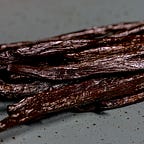Vanilla Cultivation
Vanilla Cultivation
Initially, vanilla is native to Central America and it is the Melipone bee, a species endemic to Mexico, that proves to be the only insect capable of fertilizing the vanilla flower. However, the insect which ensures the fertilization was not “imported” in the countries where the culture of the vanilla was spread. Therefore, pollination must still be done manually flower by flower with a tassel.
Vanilla planifolia needs a warm and humid climate to grow as well as some shade and support. Three planting systems are considered for the cultivation of vanilla, which you will discover in the article.
The pollination of vanilla
Without external intervention, the pollination of vanilla is not possible. It must be done manually flower by flower by the hand of Man.
The fertilization is an essential step to obtain vanilla pods because without it, there is no obtaining the fruit. The pollination is practiced in dry weather every morning as the flowers have a short life of a few hours. With a pointed instrument, the picker tears the cap of the vanilla flower that protects the male part.
Still with her instrument, she then straightens the tongue that separates the female part from the male part and she brings the stamen carrying the pollen closer with her fingers. After this pollination, the base of the vanilla flower will elongate and move downwards to form the green vanilla pod. Two months later, the dried flower falls off and the vanilla bean has reached its final size. Eight to nine months after fertilization, the vanilla bean is ready to be harvested. The “marieuses” can fertilize from 1000 to 1500 flowers per day.
Did you know that?
Edmond Albius is a slave from Reunion who discovered, in 1841, the process of fertilization of vanilla. At the age of 12, Edmond was able to produce vanilla pods in his master’s garden to his master’s great surprise. No one had ever successfully fertilized vanilla before. The young slave then explained the simple and very reliable process of hand pollinating vanilla. This method was then adopted by many planters and Reunion began to produce and export vanilla.
The three planting systems for the cultivation of vanilla
Vanilla is cultivated in different ways from extensive to intensive modes. In most of the producing countries, vanilla is cultivated in semi-intensive mode on live stakes.
Undergrowth:
It is a system of plantation which consists in using trunks of trees as supports, of this fact one impregnates itself with the ecological decoration. This system is the most economical insofar as the vanilla tree is placed under a natural vegetation cover not implanted voluntarily it finds in general all the conditions favourable to its culture: shade, organic matter resulting from the decomposition of the leaves and branches of the plant cover. A too dense forest would cause a strong rate of shade and moisture which would generate a starvation. Beforehand, trees capable of supporting the weight of the vanilla tree are planted in the vanilla plantations to act as “stakes”. These trees are often coffee, avocado or mango trees.
Semi-intensive :
Consists in improving the previous framework by intercalating, for example, vanilla between sugar canes; an adapted stake is chosen that will support the vanilla tree. A development of the zone is often essential. The only species that meets the requirements is Gliricidia, a species that has proven itself as a tutor for vanilla in many countries due to its robustness and lack of disease.
The intensive system:
Consists of an optimal management of the culture conditions (shading, feeding and irrigation). This last system makes it possible to extend the area of culture and to implant vanilla trees even in dry zones. The intensive vanilla cultivation system includes artificial shade, dead stakes and a supplemental irrigation system, which allows to meet the requirements of the vanilla tree in a precise, efficient and sustainable way.
